seats FIAT 500 2020 Owner handbook (in English)
[x] Cancel search | Manufacturer: FIAT, Model Year: 2020, Model line: 500, Model: FIAT 500 2020Pages: 228, PDF Size: 6.01 MB
Page 9 of 228
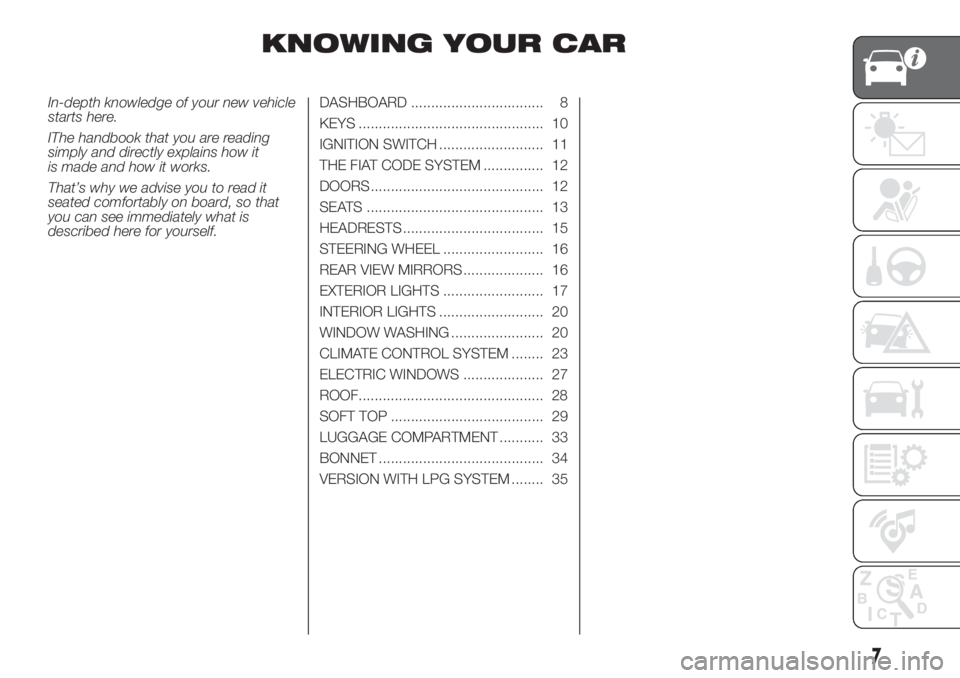
KNOWING YOUR CAR
In-depth knowledge of your new vehicle
starts here.
IThe handbook that you are reading
simply and directly explains how it
is made and how it works.
That’s why we advise you to read it
seated comfortably on board, so that
you can see immediately what is
described here for yourself.DASHBOARD ................................. 8
KEYS .............................................. 10
IGNITION SWITCH .......................... 11
THE FIAT CODE SYSTEM ............... 12
DOORS ........................................... 12
SEATS ............................................ 13
HEADRESTS ................................... 15
STEERING WHEEL ......................... 16
REAR VIEW MIRRORS .................... 16
EXTERIOR LIGHTS ......................... 17
INTERIOR LIGHTS .......................... 20
WINDOW WASHING ....................... 20
CLIMATE CONTROL SYSTEM ........ 23
ELECTRIC WINDOWS .................... 27
ROOF.............................................. 28
SOFT TOP ...................................... 29
LUGGAGE COMPARTMENT ........... 33
BONNET ......................................... 34
VERSION WITH LPG SYSTEM ........ 35
7
Page 15 of 228

On versions with central locking, when
the key is turned, the doors and the
tailgate are simultaneously locked.
Lock / Unlock from inside: act on the
handles on the door panels fig. 8.
Position 1: the door is unlocked.
Position 2: the door is locked.
On versions with door central locking,
the driver's and passenger's side
handles lock/unlock both doors and
tailgate.
IMPORTANT The locked door condition
is indicated by the red symbol A fig. 8
on the interior door handle.
With remote control
Press the
button: door locking.
Press the
button: door unlocking.
WARNING
6)Before opening a door, ensure that you
can do it in conditions of safety. Open
the doors only when the vehicle is
stationary.
WARNING
2)Make sure to take the key with you once
a door or the tailgate is locked, to prevent
locking the same key inside the vehicle.
If the key is locked inside, it can only be
retrieved by using the second key
provided.
SEATS
FRONT SEATS
7) 8)
3)
Longitudinal adjustment
Lift lever A fig. 9 and push the seat
forwards or backwards: in the driving
position your arms should rest on
the steering wheel rim.
9)
8F0S0357
9F0S0013
13
Page 17 of 228
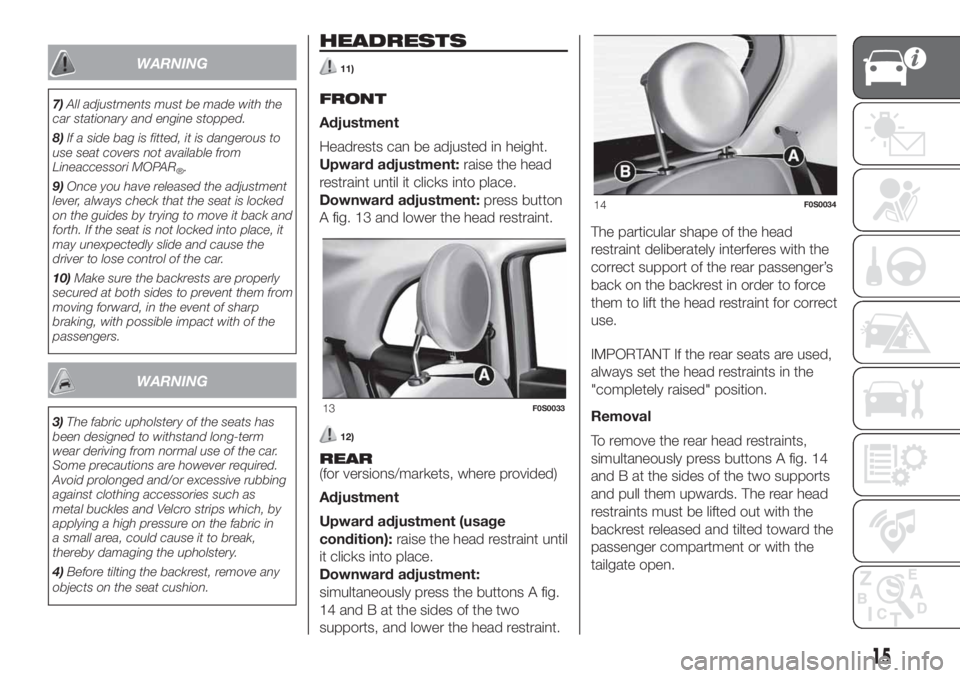
WARNING
7)All adjustments must be made with the
car stationary and engine stopped.
8)If a side bag is fitted, it is dangerous to
use seat covers not available from
Lineaccessori MOPAR
®.
9)Once you have released the adjustment
lever, always check that the seat is locked
on the guides by trying to move it back and
forth. If the seat is not locked into place, it
may unexpectedly slide and cause the
driver to lose control of the car.
10)Make sure the backrests are properly
secured at both sides to prevent them from
moving forward, in the event of sharp
braking, with possible impact with of the
passengers.
WARNING
3)The fabric upholstery of the seats has
been designed to withstand long-term
wear deriving from normal use of the car.
Some precautions are however required.
Avoid prolonged and/or excessive rubbing
against clothing accessories such as
metal buckles and Velcro strips which, by
applying a high pressure on the fabric in
a small area, could cause it to break,
thereby damaging the upholstery.
4)Before tilting the backrest, remove any
objects on the seat cushion.
HEADRESTS
11)
FRONT
Adjustment
Headrests can be adjusted in height.
Upward adjustment:raise the head
restraint until it clicks into place.
Downward adjustment:press button
A fig. 13 and lower the head restraint.
12)
REAR
(for versions/markets, where provided)
Adjustment
Upward adjustment (usage
condition):raise the head restraint until
it clicks into place.
Downward adjustment:
simultaneously press the buttons A fig.
14 and B at the sides of the two
supports, and lower the head restraint.The particular shape of the head
restraint deliberately interferes with the
correct support of the rear passenger’s
back on the backrest in order to force
them to lift the head restraint for correct
use.
IMPORTANT If the rear seats are used,
always set the head restraints in the
"completely raised" position.
Removal
To remove the rear head restraints,
simultaneously press buttons A fig. 14
and B at the sides of the two supports
and pull them upwards. The rear head
restraints must be lifted out with the
backrest released and tilted toward the
passenger compartment or with the
tailgate open.
13F0S0033
14F0S0034
15
Page 76 of 228
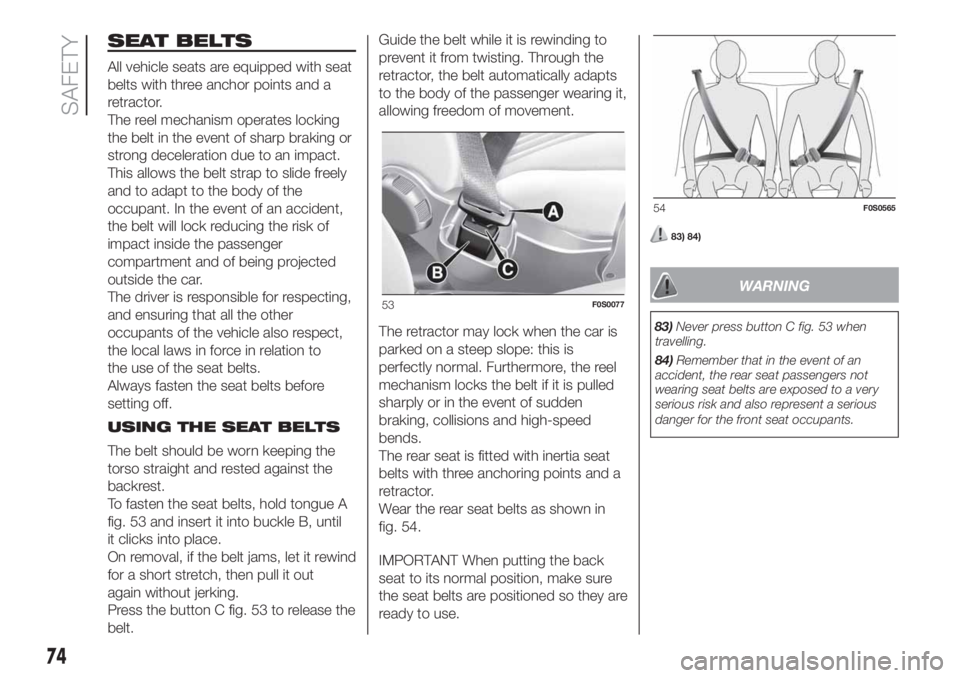
SEAT BELTS
All vehicle seats are equipped with seat
belts with three anchor points and a
retractor.
The reel mechanism operates locking
the belt in the event of sharp braking or
strong deceleration due to an impact.
This allows the belt strap to slide freely
and to adapt to the body of the
occupant. In the event of an accident,
the belt will lock reducing the risk of
impact inside the passenger
compartment and of being projected
outside the car.
The driver is responsible for respecting,
and ensuring that all the other
occupants of the vehicle also respect,
the local laws in force in relation to
the use of the seat belts.
Always fasten the seat belts before
setting off.
USING THE SEAT BELTS
The belt should be worn keeping the
torso straight and rested against the
backrest.
To fasten the seat belts, hold tongue A
fig. 53 and insert it into buckle B, until
it clicks into place.
On removal, if the belt jams, let it rewind
for a short stretch, then pull it out
again without jerking.
Press the button C fig. 53 to release the
belt.Guide the belt while it is rewinding to
prevent it from twisting. Through the
retractor, the belt automatically adapts
to the body of the passenger wearing it,
allowing freedom of movement.
The retractor may lock when the car is
parked on a steep slope: this is
perfectly normal. Furthermore, the reel
mechanism locks the belt if it is pulled
sharply or in the event of sudden
braking, collisions and high-speed
bends.
The rear seat is fitted with inertia seat
belts with three anchoring points and a
retractor.
Wear the rear seat belts as shown in
fig. 54.
IMPORTANT When putting the back
seat to its normal position, make sure
the seat belts are positioned so they are
ready to use.
83) 84)
WARNING
83)Never press button C fig. 53 when
travelling.
84)Remember that in the event of an
accident, the rear seat passengers not
wearing seat belts are exposed to a very
serious risk and also represent a serious
danger for the front seat occupants.
53F0S0077
54F0S0565
74
SAFETY
Page 77 of 228
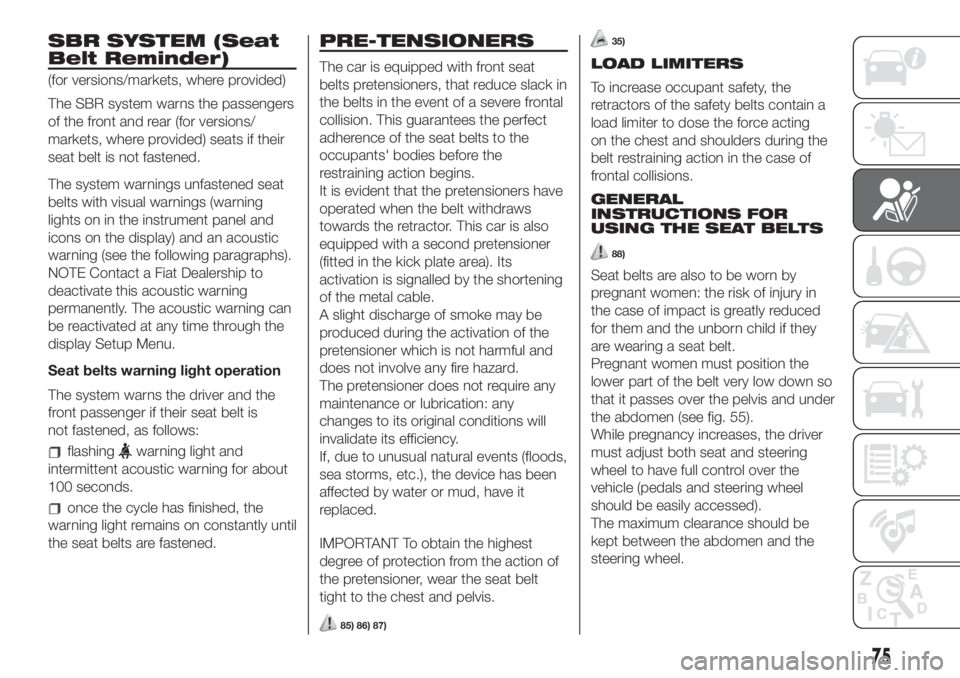
SBR SYSTEM (Seat
Belt Reminder)
(for versions/markets, where provided)
The SBR system warns the passengers
of the front and rear (for versions/
markets, where provided) seats if their
seat belt is not fastened.
The system warnings unfastened seat
belts with visual warnings (warning
lights on in the instrument panel and
icons on the display) and an acoustic
warning (see the following paragraphs).
NOTE Contact a Fiat Dealership to
deactivate this acoustic warning
permanently. The acoustic warning can
be reactivated at any time through the
display Setup Menu.
Seat belts warning light operation
The system warns the driver and the
front passenger if their seat belt is
not fastened, as follows:
flashingwarning light and
intermittent acoustic warning for about
100 seconds.
once the cycle has finished, the
warning light remains on constantly until
the seat belts are fastened.
PRE-TENSIONERS
The car is equipped with front seat
belts pretensioners, that reduce slack in
the belts in the event of a severe frontal
collision. This guarantees the perfect
adherence of the seat belts to the
occupants' bodies before the
restraining action begins.
It is evident that the pretensioners have
operated when the belt withdraws
towards the retractor. This car is also
equipped with a second pretensioner
(fitted in the kick plate area). Its
activation is signalled by the shortening
of the metal cable.
A slight discharge of smoke may be
produced during the activation of the
pretensioner which is not harmful and
does not involve any fire hazard.
The pretensioner does not require any
maintenance or lubrication: any
changes to its original conditions will
invalidate its efficiency.
If, due to unusual natural events (floods,
sea storms, etc.), the device has been
affected by water or mud, have it
replaced.
IMPORTANT To obtain the highest
degree of protection from the action of
the pretensioner, wear the seat belt
tight to the chest and pelvis.
85) 86) 87)
35)
LOAD LIMITERS
To increase occupant safety, the
retractors of the safety belts contain a
load limiter to dose the force acting
on the chest and shoulders during the
belt restraining action in the case of
frontal collisions.
GENERAL
INSTRUCTIONS FOR
USING THE SEAT BELTS
88)
Seat belts are also to be worn by
pregnant women: the risk of injury in
the case of impact is greatly reduced
for them and the unborn child if they
are wearing a seat belt.
Pregnant women must position the
lower part of the belt very low down so
that it passes over the pelvis and under
the abdomen (see fig. 55).
While pregnancy increases, the driver
must adjust both seat and steering
wheel to have full control over the
vehicle (pedals and steering wheel
should be easily accessed).
The maximum clearance should be
kept between the abdomen and the
steering wheel.
75
Page 78 of 228
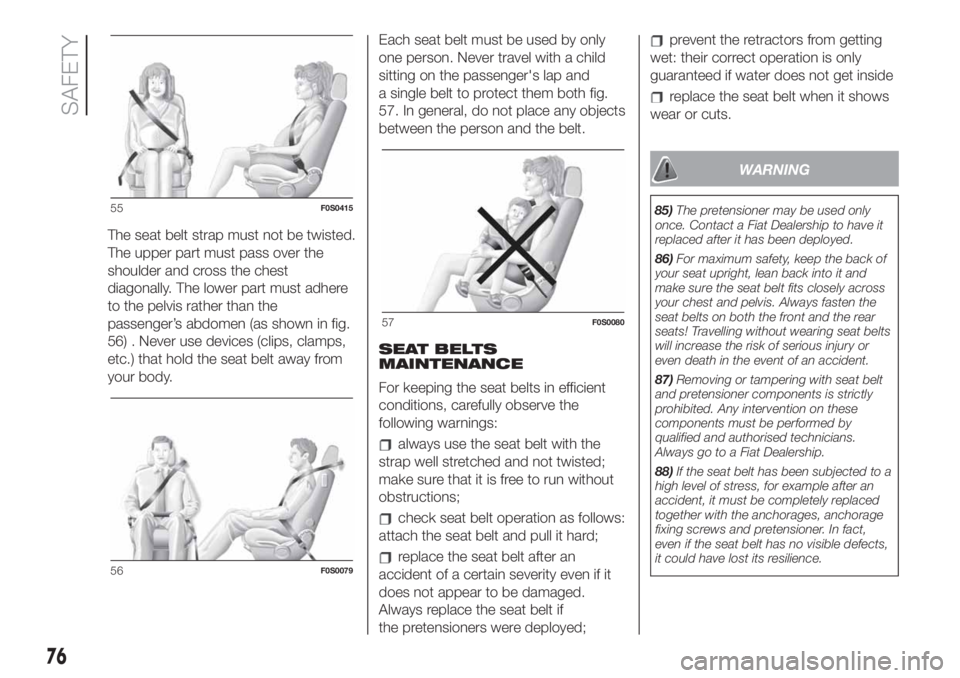
The seat belt strap must not be twisted.
The upper part must pass over the
shoulder and cross the chest
diagonally. The lower part must adhere
to the pelvis rather than the
passenger’s abdomen (as shown in fig.
56) . Never use devices (clips, clamps,
etc.) that hold the seat belt away from
your body.Each seat belt must be used by only
one person. Never travel with a child
sitting on the passenger's lap and
a single belt to protect them both fig.
57. In general, do not place any objects
between the person and the belt.
SEAT BELTS
MAINTENANCE
For keeping the seat belts in efficient
conditions, carefully observe the
following warnings:
always use the seat belt with the
strap well stretched and not twisted;
make sure that it is free to run without
obstructions;
check seat belt operation as follows:
attach the seat belt and pull it hard;
replace the seat belt after an
accident of a certain severity even if it
does not appear to be damaged.
Always replace the seat belt if
the pretensioners were deployed;
prevent the retractors from getting
wet: their correct operation is only
guaranteed if water does not get inside
replace the seat belt when it shows
wear or cuts.
WARNING
85)The pretensioner may be used only
once. Contact a Fiat Dealership to have it
replaced after it has been deployed.
86)For maximum safety, keep the back of
your seat upright, lean back into it and
make sure the seat belt fits closely across
your chest and pelvis. Always fasten the
seat belts on both the front and the rear
seats! Travelling without wearing seat belts
will increase the risk of serious injury or
even death in the event of an accident.
87)Removing or tampering with seat belt
and pretensioner components is strictly
prohibited. Any intervention on these
components must be performed by
qualified and authorised technicians.
Always go to a Fiat Dealership.
88)If the seat belt has been subjected to a
high level of stress, for example after an
accident, it must be completely replaced
together with the anchorages, anchorage
fixing screws and pretensioner. In fact,
even if the seat belt has no visible defects,
it could have lost its resilience.55F0S0415
56F0S0079
57F0S0080
76
SAFETY
Page 79 of 228

WARNING
35)Operations which lead to impacts,
vibrations or localised heating (over 100°C
for a maximum of six hours) in the area
around the pretensioner may damage or
deploy it. Contact a Fiat Dealership should
intervention be necessary on these
components.
CHILD PROTECTION
SYSTEMS
CARRYING CHILDREN
SAFELY
89) 90) 91) 92)
For optimal protection in the event of an
impact, all occupants must be seated
and wearing adequate restraint
systems, including newborn and other
children! This prescription is
compulsory in all EC countries
according to EC Directive 2003/20/EC.
Children below the height of 1.50
metres and up to 12 years must be
protected with suitable restraint
systems and be seated on the rear
seats.
Statistics on accidents indicate that the
rear seats offer greater safety for
children.
Compared with an adult, a child's head
is larger and heavier in proportion to
their body and the child's muscular and
bone structures are not fully developed.
Therefore, correct restraint systems
other than adult seat belts are
necessary to reduce as much as
possible the risk of injuries in the event
of an accident, braking or sudden
manoeuvre.Children must be seated safely and
comfortably. As far as the
characteristics of the child seats used
allow, you are advised to keep children
in rear facing child seats for as long
as possible (at least until 3–4 years old),
since this is the most protected
position in the event of an impact.
The choice of the most suitable child
restraint system depends on the weight
and size of the child. There are various
types of child restraint systems, which
can be secured to the car by means
of the seat belts or with the ISOFIX
anchorages.
It is recommended to always choose
the restraint system most suitable
for the child; for this reason always refer
to the Owner Handbook provided with
the child restraint system, to be sure
that it is of the right type for the children
it is intended for.
For correct installation on the car, some
universal child restraint systems require
an accessory (base) sold separately
by the restraint system's producer.
Therefore, FCA advises customers to
check that their chosen child restraint
system can be installed on their vehicle
by performing a trial installation, on
the vendor's premises, before
purchase.
77
Page 82 of 228

PASSENGER SEAT COMPLIANCE WITH REGULATIONS ON UNIVERSAL CHILD
RESTRAINT SYSTEM USE
The car complies with European Directive 2000/3/EC which governs the arrangement possibilities for child restraint systems on
the various seats of the car as shown in the following table:
Group Weight rangeFront passenger(*)Rear passenger
Airbag enabled Airbag disabled
Group 0, 0+ up to 13 kgXUU
Group 1 9 - 18 kgXUU
Group 2 15 - 25 kgUUU
Group 3 22–36 kgUUU
(*) IMPORTANT: NEVER fit a rearward-facing child seat in the front passenger seat if the airbag is active. If you wish to fit a rearward-facing child restraint system in
the front passenger seat, first deactivate the relative airbag (see instructions in the paragraph "Supplementary protection system (SRS) – Airbag”).
X Seat not suitable for children in this weight category.
U Suitable for child restraint systems in the "Universal" category, according to European Standard ECE-R44 for the specified "Groups".
80
SAFETY
Page 83 of 228
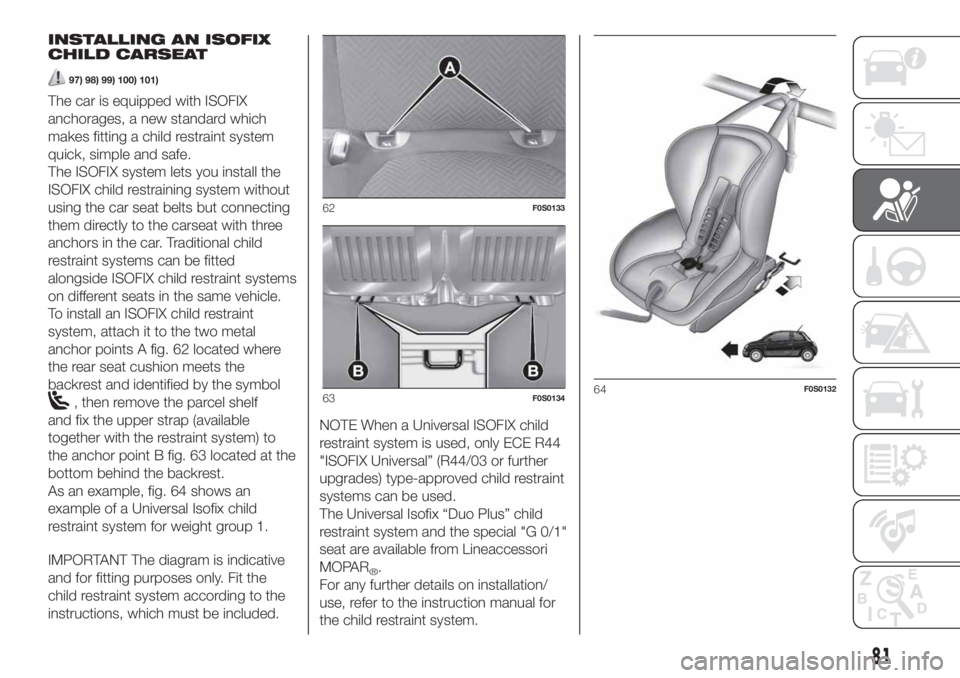
INSTALLING AN ISOFIX
CHILD CARSEAT
97) 98) 99) 100) 101)
The car is equipped with ISOFIX
anchorages, a new standard which
makes fitting a child restraint system
quick, simple and safe.
The ISOFIX system lets you install the
ISOFIX child restraining system without
using the car seat belts but connecting
them directly to the carseat with three
anchors in the car. Traditional child
restraint systems can be fitted
alongside ISOFIX child restraint systems
on different seats in the same vehicle.
To install an ISOFIX child restraint
system, attach it to the two metal
anchor points A fig. 62 located where
the rear seat cushion meets the
backrest and identified by the symbol
, then remove the parcel shelf
and fix the upper strap (available
together with the restraint system) to
the anchor point B fig. 63 located at the
bottom behind the backrest.
As an example, fig. 64 shows an
example of a Universal Isofix child
restraint system for weight group 1.
IMPORTANT The diagram is indicative
and for fitting purposes only. Fit the
child restraint system according to the
instructions, which must be included.NOTE When a Universal ISOFIX child
restraint system is used, only ECE R44
"ISOFIX Universal” (R44/03 or further
upgrades) type-approved child restraint
systems can be used.
The Universal Isofix “Duo Plus” child
restraint system and the special "G 0/1"
seat are available from Lineaccessori
MOPAR
®.
For any further details on installation/
use, refer to the instruction manual for
the child restraint system.
62F0S0133
63F0S013464F0S0132
81
Page 84 of 228

SUITABILITY OF PASSENGER SEATS FOR ISOFIX CHILD RESTRAINT SYSTEM USE
The table below shows the various possibilities for installing Isofix child restraint systems on seats fitted with specific
attachments in accordance with European standard ECE 16.
Weight groupChild restraint system
positionIsofix size class Rear side Isofix position
Group 0 up to 10 kg Rear facing EX
Group0+0to13kgRear facing E
X
Rear facing DX
Rear facing CX
Group1from9to18kgRear facing D
X
Rear facing CX
Forward facing BIUF
Forward facing B1IUF
Forward facing AIUF (*)
X: Isofix position not suitable for Isofix child restraint system in this weight group and/or size class.
IUF: Suitable for forward facing Isofix child restraint systems in the Universal category and type-approved for the use in the weight group.
(*)This Isofix position is not suitable for Isofix child restraint systems in this group of weight and/or size class.
The other weight groups are covered by specific ISOFIX child restraint systems, which can be used only if specifically tested for
this car (see list of cars provided with the child restraint system).
82
SAFETY